Thank you for being able to help me out with these tasks.
Please keep me updated whilst you work on the tasks and feel free to ask as many questions as you need.
You can update me at the end of each work block (and ask questions any time they come up, the questions can’t be too small).
I will keep updating this page with the new work instructions.
- Add New Research Articles
- Add Older Summaries
1. Add New Research Articles
Overview
I will add new research articles as drafts with minimal information (e.g. title and link to the article and the article uploaded if it’s available).
You can then add the details to the post and save it as a draft.
I will then double-check, provide necessary feedback, add the image, and post the article.
Details
See the video above for the full walkthrough of the instructions.
Step 0: Login
1. Log in to Wordtune
https://app.wordtune.com/account/login?product=read
Email: [email protected]
Password: as provided (@…c)
2. Log in to WordPress
https://blossomanalysis.com/wp-admin/
Name: upwork
Password: as provided (%…I)
Step 1: Find the pages (papers) in WordPress
Go to the posts – in the ‘type’ named ‘papers’ and filter for only those with the tag ‘to add’
You can do this by going to this link directly: https://blossomanalysis.com/wp-admin/edit.php?post_type=papers&tag=to-add
After we find the paper, we click on the title (right-click/middle-mouse to open in new tab, so we don’t lose the overview page).
Here is a visual representation of this:
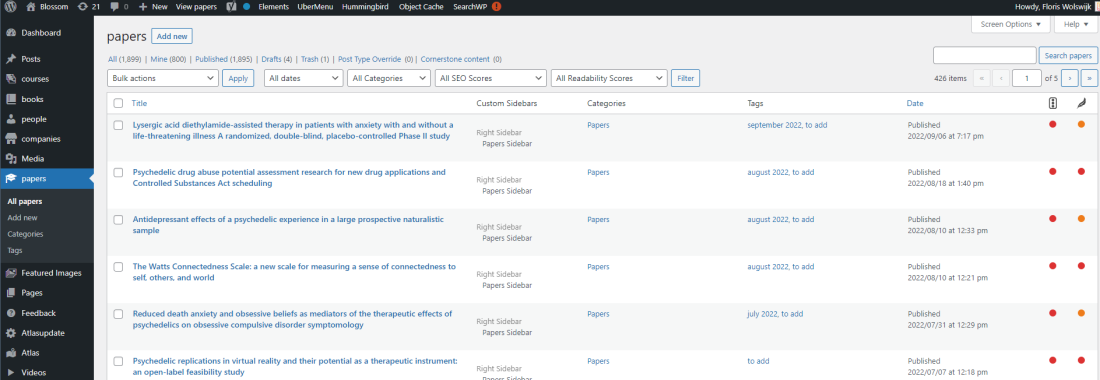
This is the papers overview page, showing only the ‘to add’ pages

Right-mouse (or middle mouse) to open this page in a new tab. You can click on edit or click on the title.
Step 3. Add the information to the articles
- You are now on the individual ‘paper’ page, here you will start filling in information
- Open a new browser/tab and go to the ‘Google Scholar URL’ link
- you can find the link by scrolling down a bit
- if this link is not there, do the following;
- Copy the title of the paper
- Go to scholar.google.com
- Paste the title of the paper
- Copy the URL (of the page you are on) to the ‘Google Scholar URL’ field
- The paper should be the first result
- Right-click on the title of the paper
- Copy the link address
- Paste the URL in ‘Primary URL’
- Then you need to find the ‘Secondary URL’
- Click on ‘All X versions’ (in Google Scholar)
- see the image below where to find ‘All X versions’
- Right-click on the title of the next version of the paper (the second result)
- Copy the link address
- Paste the URL in ‘Secondary URL’
- Then you need to find the ‘doi URL’
- This can be found on the individual page of a paper
- It looks like: https://doi.org/10.1016/j.psychres.2020.112907
- If you can’t find it, just skip this step
- You can also find the ‘Number of Citations’ here (on Google Scholar)
- Fill in that number
- this is (almost) always 0 for very recent papers
- In the other browser/tab you can now go to the paper itself by clicking on the first result (the ‘Primary URL’)
- it is best if you have this on a second screen (use two screens) or have one browser on the left half, the other on the right half
- We will now work on the text on the page
- Type the text ‘Abstract of [title of paper]’ in the text field
- the text field, before there is anything typed, says ‘Start writing or type / to choose a block’
- Then hover your mouse over the word Abstract
- Then hover your mouse over this symbol ‘¶‘
- The symbol will change to two arrows
- Click on the two arrows
- Then click on Heading
- this will change the word Abstract into a title
- Then click on H2
- Then click on the white space below the world Abstract
- this starts a new line
- You can also change the order here (i.e. make it a H2 before starting typing)
- Copy the ‘Abstract’ text from the paper
- Paste the text (on the new line you started)
- Remove any unnecessary enters (there should be no enters in the text, see example below)
- Add quote marks before and after the text ” ….. “
- Double-click on the text
- this will select all the text
- Select the ‘I’ symbol to make the whole text italic (or use CTRL+i on your keyboard)
- Then click on the white space below the text
- this starts a new line
- We now go back to the ‘metadata’, we go to ‘Substance Studied’
- Click on the substance that is studied
- This information should be in the abstract
- you can select multiple by holding down the key CTRL (CMD)
- Add the information for ‘Substance Min’ and ‘Substance Max’ and ‘Substance Amount’
- this information is not always there, if it’s not there, you can leave this empty
- This is also in the abstract and is usually given as follows;
- 10mg/70kg; this means = 10mg is given for a person of 70kg
- You then fill in 10 (min), 10 (max), mg (amount)
- It can also be given as follows;
- 1mg, 5mg, 10mg at 70kg
- You then fill in 1 (min), 10 (max), mg (amount)
- It can also be given as follows;
- 0.05mg per kg
- You can then multiply it by 70
- You then fill in 3.5mg (min), 3.5mg (max), mg (amount)
- Click on the outcome or topic that is studied
- This information should be in the abstract
- you can select multiple by holding down the key CTRL (CMD)
- Select if the study is an individual study or meta study (about other studies)
- Examples of Individual studies: survey, experiment, interviews, mice study, fMRI study
- Examples of Meta studies: meta analysis, literature review, book chapter, opinion piece
- Fill in ‘Date Published UNIX’
- The date formatting is YYYY-MM-DD
- e.g. 2010-10-30 (30 October 2010)
- the date of the paper is usually on the top of the page (see image below)
- sometimes it doesn’t have a specific day, then you can add it as the first day of that month
- if you can’t find the date, just leave it empty
- Fill in ‘Date Published COPY’
- Copy the date from the last step to this field
- Fill in ‘Number of Subjects’
- This information should be in the Abstract
- this is the total number of subjects in the experiment;
- so not only those who received the treatment/drug;
- Fill in ‘Active subjects’
- This is the number of people who got the active (psychedelic) dose (not the placebo)
- in many cases people get both the placebo and active dose (within-subject/cross-over), so the number is the same as the last one
- Fill in ‘Subject Type’
- This is almost always ‘Humans’ but select another one if it’s the case
- Fill in ‘Study Characteristics’
- This information should be in the Abstract
- Use CTRL (CMD) to select multiple characteristics
- ‘bio/neuro’ = studies on the brain (structures)
- We will now go/look back at the page of the paper itself
- Select the ‘Journal’ that it’s published in
- This can be found on the page of the paper
- if the journal is not there, (which is unlikely) you can add it in the same way as that for Authors (see next)
- Add and select the Authors
- in most cases one or multiple of the authors are not in the list yet
- Add an author by, in a new browser/tab, go to Meta Box -> Custom Fields -> Science Meta
- it is good to leave this page open
- In ‘Fields’ you can scroll down to Authors
- Click on Authors
- In Choices, add the authors as follows;
- you can make the ‘box’ larger by dragging the bottom-right corner down
- Lastname, F. S.
- (first, second, third, etc names)
- If the last name is ‘de Pieters’, the name will be; de Pieters, F. S.
- Add the names in alphabetical order
- Click ‘Update’ (bottom right)
- Then go back to the page of the paper
- Here you have to ‘Save Draft’ on the top right corner
- And then refresh the page (CLTR+F5 or the ↻ button in your browser)
- this way the ‘paper page’ also knows what you just added
- After you’ve added all authors that were not in the list
- Use CTRL (CMD) to select the authors
- Select if the paper is ‘Open Access’ or ‘Paywall’
- This is already selected as ‘Paywall’, this is the value in most cases
- This means that the paper itself is not publicly available (people can only see the abstract)
- You can set it to ‘Open Access’ if the whole paper is available
- This is so when you can read/find more than the instruction
- In Google Scholar, you can also see this as a PFD or HTML file is indicated on the right (see the image below)
- Add the tag (this is located in the right bar) ‘to review’ (or send on whatsapp)
- you can type the words and press enter
- or type ‘to r’ and click on the ‘to review’ text
- Then click ‘Save Draft’ on the top right
If you stop somewhere in the process
- Then add the tag ‘stopped here’
- So you know where to start again next time
If you are finished with a paper, you can start again at step 2.
Images that may help with finding specific buttons
2.

7.

12.

16.

26.

Step 4: Adding the short summary
Go to https://chat.openai.com/
In the chat interface copy the following instruction
Please summarize the information below in the following format
This [type of study] (n=[number of participants]) [more details if available in 2 sentences].
Example1: This survey (n=2045) of Canadian psychedelic users finds psilocybin, MDMA and LSD are the most commonly used. It also reports positive (82%) life changes and challenging experiences (52%). Motivations for use include fun, self-exploration, general mental well-being, and personal growth.
Example2: This pre-print open-label trial (n=14) organised by ATMA Journey Centers finds psilocybin to be safe, with peak systolic (146) and diastolic (94) blood pressures to be within acceptable ranges. Secondary analyses find a significant decrease in depression (QIDS-SR16) and high mysticism scores (MEQ-30).
Example3: This double-blind, randomized Phase III trial (n=227) finds no significant difference between esketamine plus a new antidepressant versus only the antidepressant (and a placebo) at day 28 on depression scores (MADRS). The study reports one death in the esketamine group. It also states esketamine to be "effective and safe" though only the first claim could be credibly made if one only looks at the immediate (24-hour) effects.
Example4: This pre-print re-analysis (n=48) of microdosing LSD (5-20μg) finds that LSD reduces the influence of our expectations (precision-weighted local priors) on what we think time should feel like (under-reproduction bias). When controlling for the expectations, the bias disappears, indicating that LSD microdosing reduces the relative weighting of priors (expectations).
Now comes the information that I want you to summarize:(in the same message, copy the abstract of the article).
Now copy the output to the article page (top of the text field, above the abstract)
Also copy the text to the ‘excerpt’ that is situated in the right-side column.
And copy the text to the ‘meta description’ under the Yoast SEO section (edit this so that the bar below it becomes green – i.e. shorten it a bit).
Step 5: Adding the long summary
Go to: https://app.wordtune.com/read/library
This page may take a moment to load, but will look like this:

On the WordTune page we can see all the individual summaries (we see three here).
Now add the .pdf (that you can download from the individual paper page) to wordtune so it starts loading in the article.
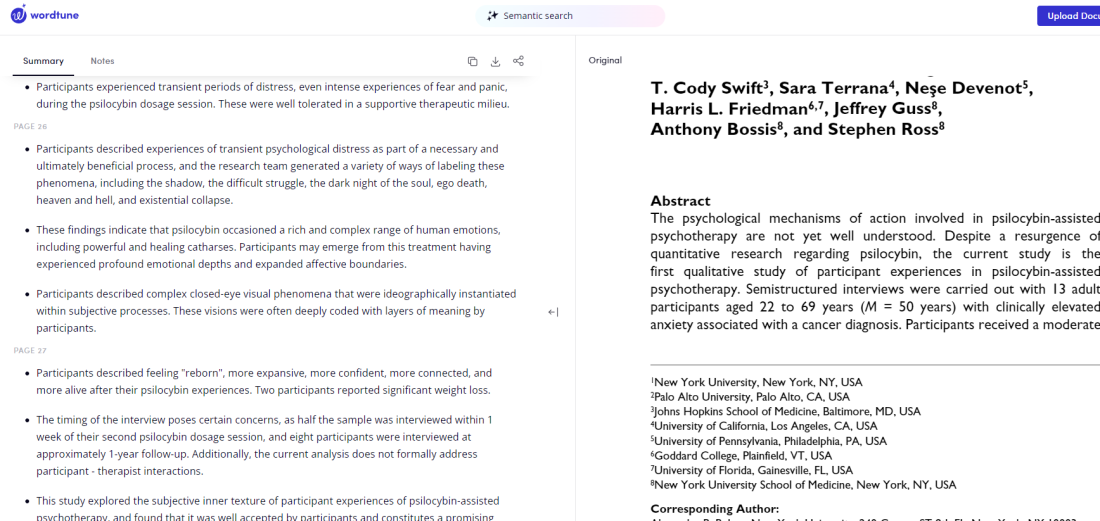
This is the page where we have the summary.
You can copy the text of the summary by clicking on the copy button. Then after clicking on the copy button. After you click the button, the text is now copied.

Click to copy the text.
Now that we have the text, we will go back to the other screen and paste it on the page.
Step 5a: Paste the summary
On the WordPress page, we scroll down until we are at the end of the main text area. This is below all the other text that is there, and above where the other information starts. For me this is ‘Papers Meta’, but it could also say something else below. Just know that you are at the end of the text field.
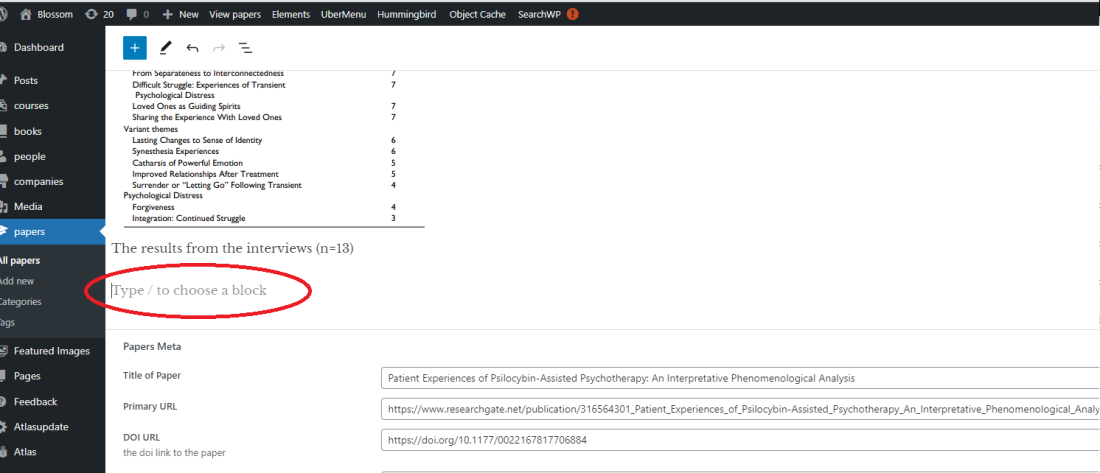
Your view may be slightly different, but we are looking for the area I circled ‘Type / to choose a block”.
Here you will type “/sum” and select “Summary New”.
This will open a template block which we will and to decouple.
You can do this by pressing the : (three dots) symbol and then “Detach patterns”.

This is how that looks like.
Then change the title to “Summary of [Title of article].
And then we can paste in the text of the summary in the place where it now says “BB” (in the member content)
And now, we will paste the summary (ctrl + v).

This is how the page will look like after pasting the summary.
Now you can update the summary by cutting & pasting the first three paragraphs to the top (where it says “AA” now).
And then going through the text and adjusting the headers etc. (see the video, will probably update this later to be more explicit).
Now we are going to edit the summary by adding the right headers where necessary.
This will differ per research paper, but in 99% of the cases there are headers that need to be edited.
You can change some text into a header by typing “###” and then pressing [spacebar]. This will change it into a smaller header than the “Summary …” we had at the start.
Type “### [spacebar] ” to make this a smaller title.
You will now go through the whole summary and edit the headings where necessary.
Also, see the video again if you need more instructions on the editing of headers.
Step 6: Save the page and add a tag
We will now add a tag, and save the page.
On the right side of your screen, you will see the following.

This is what we want to see. See below for instructions on how to see this.
If you don’t see anything on the right side of your screen, press the icon that is on the right side of the ‘Update” button.

If you press this button, the settings will open.
But here you may see the settings for the ‘block’ instead of the ‘papers’. So click on ‘papers’ and scroll down to see the ‘tags’.

If you click here, you will see the right sections, just scroll down to ‘tags’.
Then in tags click in the box and type “to review” and press enter to add this tag.
Also, remove the tag “to add”.

When you type “to review” and press enter it will add this tag.
Now we are finished with adding the summary.
Press “Save Draft”.

Please don’t close this tab until you see a pop-up in the bottom-left that says “Papers updated” or just leave the tab open (you don’t have to look at the tab, it will update in the background).

If you see this on the bottom–left of the screen (or if you see the blue “Updating” change to “Update” again) you know the page has been updated.
That is all for this page. You can now close it and go back to the overview.
You should have that tab open, but here is the link again: https://blossomanalysis.com/wp-admin/edit.php?post_type=papers&tag=to-add
STOP READING HERE | BELOW IS THE ORIGINAL TASK DESCRIPTION FOR DOING MORE EDITS ON THE SUMMARIES | WE MIGHT DO THIS AT A LATER STAGE
You can also find a video of me going through the task here:
Step 0: Login
1. Log in to Wordtune
https://app.wordtune.com/account/login?product=read
Email: [email protected]
Password: as provided (@…c)
2. Log in to WordPress
https://blossomanalysis.com/wp-admin/
Name: upwork
Password: as provided (%…I)
Step 1: Find the pages (papers) in WordPress
Go to the posts – in the ‘type’ named ‘papers’ and sort them by Date (with the ones published first on top).
You can do this by going to this link directly: https://blossomanalysis.com/wp-admin/edit.php?post_type=papers&orderby=date&order=asc&paged=2
Note: we are starting on page 2 (as on page 1, I still have some that don’t have the right tags).
On this page, you will search for the papers that don’t have a full summary yet (which we will later copy over from WordTune).
You can do this by looking at the papers that don’t have the tag ‘full review’. Or in other words, those with the tag ‘full review’ already have a full summary added.
After we find the paper, we click on the title (right-click/middle-mouse to open in new tab, so we don’t lose the overview page).
Here is a visual representation of this:

This is the papers overview page, sorted by date with the earliest post as first one

This is an example of a post that doesn’t have a full review yet. We will go and edit this one.

Right-mouse (or middle mouse) to open this page in a new tab. You can click on edit (as I did in this example) or click on the title.
Now we have opened a research paper and we will go and find the summary for it.
Step 2: Finding the summary
We are now on the page of the individual research paper.
Here we can see the title of the page.

We can the first few words of the title of the paper that we will use to search on WordTune.
In this case, we will copy (ctrl+c) “Patient Experiences“
We will switch to the WordTune Library (this is on the other screen).
https://app.wordtune.com/read/library
This page may take a moment to load, but will look like this:

On the WordTune page we can see all the individual summaries (we see three here).
Now we will search (ctrl+f) with the text we just copied.

We, again, will use the right-mouse to open the page in a new tab.

Now we are on the page that has the full summary.
In many cases this page will be ready immediately and you can do the following steps. In some cases this will not be the case and you will have to wait one minute. If for any reason the page doesn’t load. Start again at Step 1 and select the next page.

This is the page where we have the summary.
You can copy the text of the summary by clicking on the download button. Then after clicking on the copy button. After you click the button, the text is now copied.

Click to copy the text.
Now that we have the text, we will go back to the other screen and paste it on the page.
Step 3: Paste and edit the summary
On the WordPress page, we scroll down until we are at the end of the main text area. This is below all the other text that is there, and above where the other information starts. For me this is ‘Papers Meta’, but it could also say something else below. Just know that you are at the end of the text field.

Your view may be slightly different, but we are looking for the area I circled ‘Type / to choose a block”.
Here you will click and type “## Summary” If you type this, a heading 2 (that is made by the “##[space]” with the word “Summary” should have appeared.

Type “## [spacebar] Summary” to make this title.
Now press enter so that you see “Type / to choose a block” again.
And now we are going to paste the summary (ctrl + v).
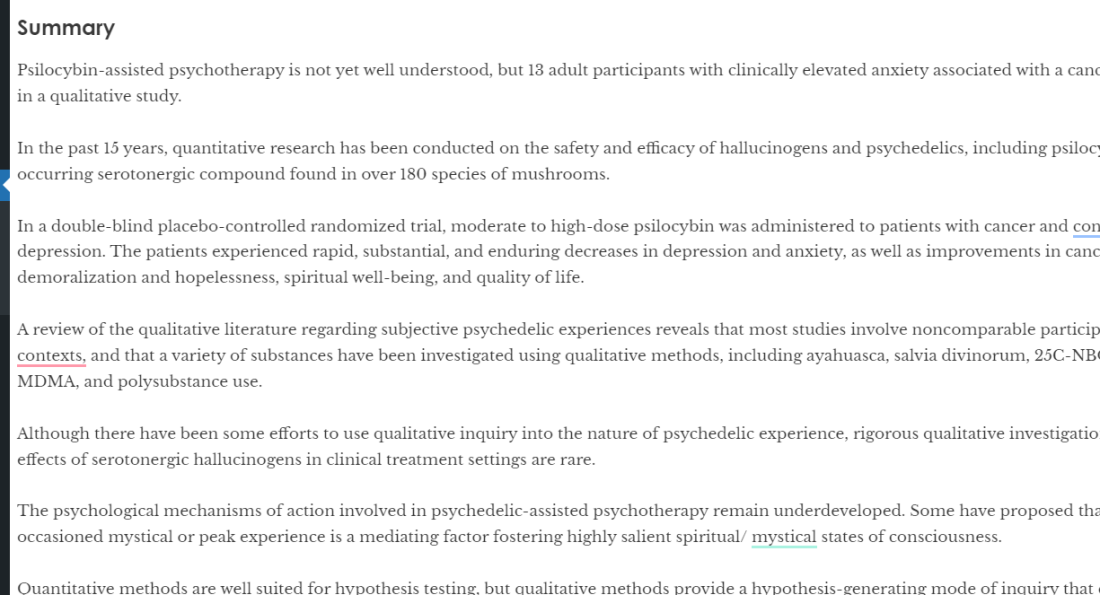
This is how the page will look like after pasting the summary.
Now we are going to edit the summary by adding the right headers where necessary.
This will differ per research paper, but in 99% of the cases there are headers that need to be edited.
You can change some text into a header by typing “###” and then pressing [spacebar]. This will change it into a smaller header than the word “Summary” we had at the start.
For instance, here I changed “Method” into a header.

Type “### [spacebar] ” to make this a smaller title.
You will now go through the whole summary and edit the headings where necessary.
Also, see the video again if you need more instructions on the editing of headers.
Now we will go to the last step, saving the page.
Step 3: Save the page and add a tag
We will now add a tag, and save the page.
On the right side of your screen, you will see the following.

This is what we want to see. See below for instructions on how to see this.
If you don’t see anything on the right side of your screen, press the icon that is on the right side of the ‘Update” button.

If you press this button, the settings will open.
But here you may see the settings for the ‘block’ instead of the ‘papers’. So click on ‘papers’ and scroll down to see the ‘tags’.

If you click here, you will see the right sections, just scroll down to ‘tags’.
Then in tags click in the box and type “to review” and press enter to add this tag.

When you type “to review” and press enter it will add this tag.
Now we are finished with adding the summary.
Press “Update”.

Please don’t close this tab until you see a pop-up in the bottom-left that says “Papers updated” or just leave the tab open (you don’t have to look at the tab, it will update in the background).

If you see this on the bottom–left of the screen (or if you see the blue “Updating” change to “Update” again) you know the page has been updated.
That is all for this page. You can now close it and go back to the overview.
You should have that tab open, but here is the link again: https://blossomanalysis.com/wp-admin/edit.php?post_type=papers&orderby=date&order=asc&paged=2
Steps 1-3: Repeat again and again
After completing one page, you can do the next one on the list.
At the end of each hour’s work, and at the end of the day (the final hour), please send me a message like this:
“I’ve added 10 ‘to review’ articles, please go to this link https://blossomanalysis.com/wp-admin/edit.php?post_type=papers&tag=to-review and leave me feedback”
In the first few days, I will try and give you feedback as quickly as possible (If I’m also at the computer).
After a few days, I think we will have everything working smoothly and then I will just check at the end of your day and give you feedback overnight.
Troubleshooting / Things we’ve come across
I’ve tried to give some instructions for issues that might come up.
But there will be other issues that come up that I haven’t anticipated. I will document them here when we’re working on them.
If there are no more pages on the overview without ‘to review’ or ‘full summary’
After every individual page has the tag ‘to review’ or ‘full summary’ (which I will add after reviewing). Then please go to the next page.

You can use the navigation here (top right) to move between the different pages.
If you can’t find the summary on WordTune
Usually, you can find the paper by searching for the first few words (2 to 4) of the title.
But sometimes the title for that is slightly different, for now just skip those.
If you find multiple results, then you can also check the author names and see if they match.
For instance, on the WordPress page, you will see:

Here you see Bogenschutz as the first author. So if you go to WordTune and search for the first words of the title “Clinical interpretations”. You will see:

Here you see Bogenschutz et al 2018 and you can find the summary here.
You can also search by the name of the first author and et al (as you see above, e.g. Bogenschutz et al (2022)). Sometimes you get the right article faster this way.
If there are no headings in the summary
For instance, in the image below, the summary has no headings yet.
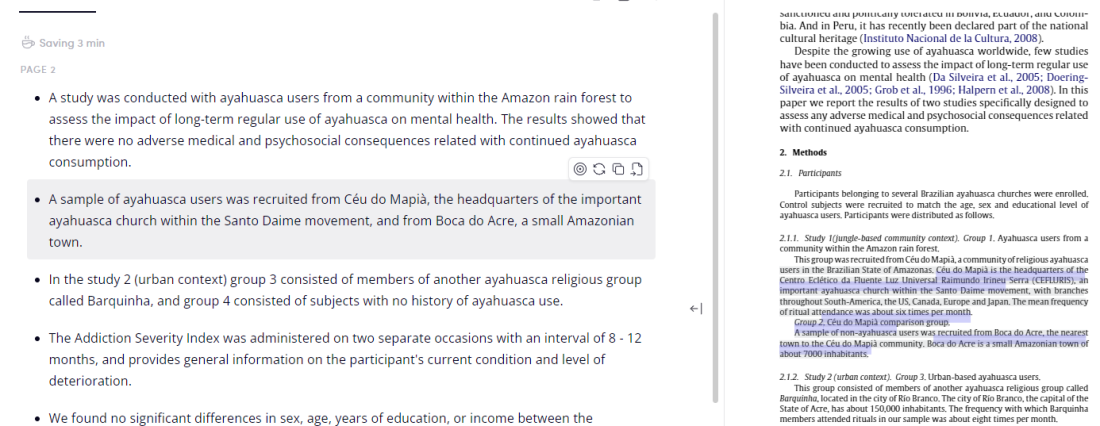
What we can do here is hover over the text on the left side (grey) and see what it is summarizing (right, violet).
Based on the information on the right, I’ve added the heading “Methods” before this text in the summary (see below).

The end (for now)
Become a psychedelic insider
Get a Pro Membership to enjoy these benefits & support Blossom📈 full reports on Topics & Compounds
🧵 full summary reviews of research papers
🚀 full access to new articles
See Memberships
